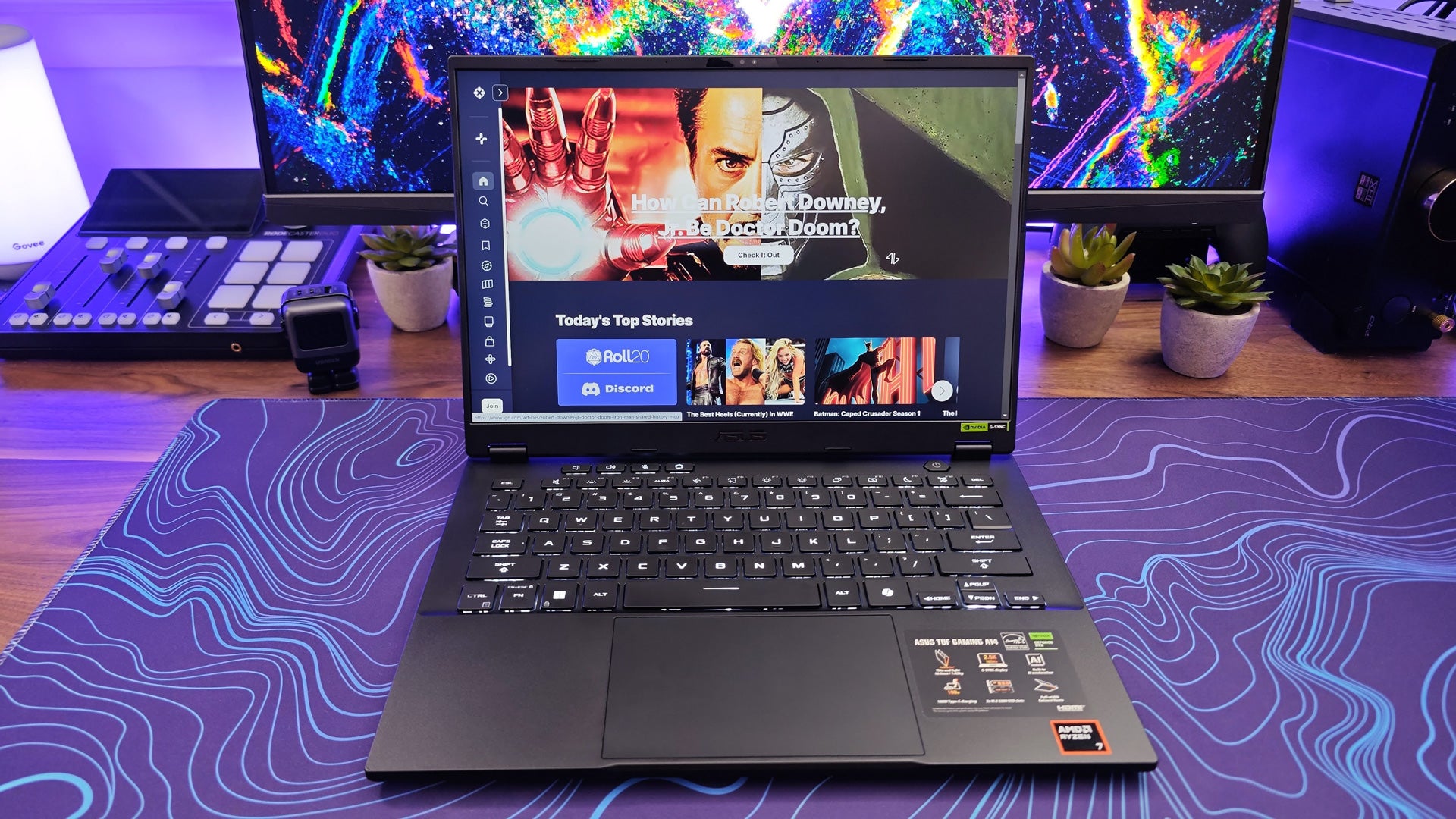The Asus TUF Gaming A14 surprised me. It’s closer to an ultrabook than a traditional gaming laptop, but don’t let its size fool you. It’s exceptionally portable but delivers impressive gaming performance for the price. There are some downsides, like its non-upgradeable memory, but the A14 is an appealing notebook for both work and play.
Asus TUF Gaming A14 (2024) – Design and Features
The Asus TUF Gaming A14 doesn’t seem like a gaming laptop at first. With a 14-inch screen, 3.2 pound weight, and 0.78-inch thinness, it looks more like a productivity laptop than something designed for gaming. There’s no RGB, no edgy designs on the chassis, and its gunmetal aluminum frame is the definition of minimalist. There’s the merest bit of branding on the lid, gray-on-gray, and if you’re not a gamer yourself, you’re not likely to make the connection.
Under the hood, it packs respectable specs, including a dedicated GPU when most laptops of this kind use integrated graphics. The A14 is available in three different configurations at launch with varying amounts of memory and an additional high-performance processor option. Our sample is the entry-level version ($1,399 from Asus) and came with the following specs.
This version features the AMD Ryzen 7 8845HS, which is a powerful processor in its own right, but represents the lower-tier performance option for the A14. It features eight cores and 16 threads for excellent performance in productivity, multitasking, and even creative work. It’s paired with 16GB of memory, which is sufficient for gaming but non-upgradeable, so if you think you may need more, it’s advisable to save up for a higher tier version. It also features an NVMe SSD with 1TB of storage, which is upgradeable – but requires reinstalling Windows since there’s only a single SSD slot onboard.
Beginning in August, two more models are set to arrive featuring AMD’s Ryzen AI 9 HX 370 processor. It upgrades the core count to twelve with 24 total threads for even better multi-core performance. It also offers much better AI capabilities thanks to its powerful Neural Processing Unit (NPU). There aren’t many mainstream apps that handle AI outside of the cloud currently but we expect this to change in the future, so you’ll be ready. It’s also more power efficient which will hopefully mean even better battery life.
Of the two models, one simply swaps the processor and will be available for $1,499 from Walmart. The second is available from AntOnline and comes in at $1,699 but pairs that processor upgrade with 32GB of memory. That’s a big increase for only 16GB of extra memory from the Walmart version, but if you’re interested in future-proofing, it’s the safest of the bunch.

No matter which you choose, it comes with a dedicated Nvidia RTX 4060 GPU. For 1080p or 1600p gaming, it’s a performer and allows you to access performance enhancing features like DLSS upscaling and frame generation. Though the RTX 4060 pales before Nvidia’s higher-tier (and much more expensive) mobile graphics cards, these two features allow you to play compatible games and at graphics settings that would otherwise be out of reach. Hundreds of games already support the tech, and most big releases tend to support it at launch now, so it adds longevity to the laptop that only a handful of years ago wouldn’t have been possible.

To extend the life of its battery, the A14 allows you to swap between its RTX graphics card and the integrated Radeon GPU built into its processor. This often boils down to “gaming” and “everything else'' modes, but things are as simple here. The Ryzen 7 8845HS features Radeon 780M graphics, the same chip powering the Lenovo Legion Go, ROG Ally X, and most other current-gen Windows gaming PCs. It won’t perform great with demanding AAA games at its native resolution, but if you’re willing to turn down to 1200p or 800p, lower settings, or are playing older or indie games, it can offer playable frame rates with much longer battery life.

The screen is good for its class, but among ultra-portables like this, it’s bested by many productivity laptops with OLED screens. It uses an IPS panel, so the colors are vivid. It’s rated at covering 100% of the sRGB color space, which was accurate when measured with my colorimeter. Asus makes no promises about its DCI-P3 coverage, but I measured that at 82.6%. Sustained peak brightness came in at 403 nits, which appears quite bright for indoor use. It appears much more faded in direct sunlight but remains usable. It also offers G-Sync compatibility and a 165Hz refresh rate for smooth gameplay and low motion blur.
Contrast is its weak point, as it is with all IPS panels, and blacks look perpetually dark gray. Unlike the Gigabyte G6X I reviewed recently, backlight bleed along the edges wasn’t a problem. Still, it would be nice to see a version of this notebook with an OLED screen. It’s so close to productivity laptops like the Asus Zenbook 14, yet quietly much more powerful. The lack of OLED was the first thing I missed during testing.

The keyboard and trackpad are quite nice. It uses chiclet keys with 1.7mm of travel and doesn't feel soft or mushy when bottomed out. There’s a satisfying tactility to pressing them that works very well when touch typing and doesn’t get in the way of how quiet they are. There’s no numpad and only a physical delete button for editing, but Asus incorporates most of what you’ll need into secondary commands you can access with the Fn button.
Navigation, for example, doubles up on the arrow keys and Print Screen now lives behind F6. There are also shortcuts along the function row to control the keyboard’s lighting (which is white only and offers only static, breathing, and strobing modes), screen brightness, airplane mode, and so on, as well as dedicated volume controls, microphone mute, and an Armoury Crate button above the function row.
The trackpad, on the other hand, is just about perfect. It’s big, measuring 5 x 3 inches, and is centered on the bottom. It was always under my thumbs but did a great job of rejecting accidental touches. Its left and right clicks are integrated and have a soft but defined feel. Like the keyboard, clicks are also very quiet, so you don’t have to worry about bothering anyone else with your clicks or clacks when typing or gaming.
The laptop comes with a quality webcam that can record up to 1080p and 30 fps. It’s good by laptop standards and, as you can see in the sample above, does a good job of balancing out light levels in challenging conditions. It’s still a bit soft compared to a standalone webcam but will work well for work and school meetings. It is also compatible with Windows Hello, so you can take advantage of Face ID to quickly login.
The speakers are passable for the size of the laptop and have more bass than I expected with how thin it is, but aren’t great overall. For music and videos, they’re functional but begin to sound distorted at higher volumes. If you’re doing more than basic listening where the quality isn’t all that important, you’ll still want to reach for headphones.
Asus TUF Gaming A14 (2024) – Software
The Asus TUF Gaming A14 uses Asus Armoury Crate for all of its configuration. Its settings are available across a number of tabs and cover performance, customizing the keyboard’s backlighting, and assigning profiles to specific games and applications. It also includes tabs to manage your game library, buy games directly from Asus, and read the latest news and updates from the company.
Thankfully, you don’t need to engage with more than the first tab very often at all. This is where all of the system’s core options are located. Its five performance modes are front and center and consist of manual, silent, performance, turbo, and Windows modes. Manual mode allows you to adjust the fan curve as well as the power draw, which is useful for balancing performance with battery life. This section is flanked by a system monitor to keep an eye on clock and fan speeds and options to choose configuration options, such as whether the Windows key or Armoury Crate buttons remain active, or whether the panel can automatically change its refresh rate when the battery is low.
The next tab offers even more options. Further broken into sections, it goes into more depth for memory management, GPU mode, the keyboard’s backlighting, and a much more detailed resource monitor that adds fps and temperature monitoring, as well as a line graph to provide more insight into its performance. There’s also an Audio section that allows you to adjust the microphone’s pick-up patterns and noise canceling behavior.
The final area of note is the GameVisual section. Here you can choose from a number of content-based presets similar to a desktop gaming monitor. There is no custom option to dial in your own settings, but Asus does provide a color temperature slider that you can adjust. I wish there were more options, however, because it’s clear that the presets are doing more than simply adjusting brightness and contrast. A pattern behind the presets gives you a bit of insight into what’s actually happening, so it’s clear the display can do it, so why keep things locked down?

If you’d rather not engage with any of this, that’s an option too. Asus has included dedicated function buttons for adjusting the laptop’s performance mode and backlighting, and the screen also looks good straight out of the box, so you’re not missing much by not choosing a preset.
Battery life is very good if you enable Advanced Optimus. This feature allows Windows to power down the RTX 4060 when it isn’t in use. In our PCMark Modern Office battery test, it lasted just shy of ten hours before powering down. That’s very impressive and speaks to the power efficiency you can expect here. Of course, if you’re gaming, the 4060 will be active and use much more power. There, it only averaged between one and two hours before needing to be plugged in.
Asus TUF Gaming A14 (2024) – Performance
Despite its small size, the TUF Gaming A14 is a surprisingly capable gaming laptop. It pushes its RTX 4060 very well and, while it doesn’t lead in all of our gaming tests, it’s no slouch and its relative quiet goes a long way to help make up for minor differences in frame rate.
We test gaming laptops using a set roster of real world and synthetic benchmarks. Games are always set to Ultra settings or are manually turned to max. Where DLSS is available, it is enabled. Frame generation results are recorded separately. We also record results for the native resolution and 1080p (or 1200p as is the equivalent for 16:10 displays like this one). Once these tests are done, we live with the laptop for around two weeks and use it as our daily driver in a wider selection of games and for everyday tasks, like drafting articles, checking email, and social media.

Beginning with our formal tests, we can see that the A14 falls slightly behind the Gigabyte G6X 9KG in synthetic tests. It’s important to note here that the G6X is a full thickness laptop so isn’t exactly in the same category as our TUF. Generally speaking, you would expect to see a slight advantage with that added cooling space, though as we’ll see later, these two are more evenly matched than you might think. Additionally, the hardware, wattage, and price are similar, so the comparison is apt. Though the G6X pulls ahead in these tests, the differences are marginal.
Pitted against the MSI Stealth 14 Studio, which is much closer in design and significantly more expensive, the A14 wins in everything but PCMark 10. The differences aren’t small either. The A14 wipes the floor with it.
In real world gaming tests the A14 performs remarkably well and offers the best frame rates of the group in most situations. Here, the graphics card is the most important component, which is the same between all three, so the results are fairly close at 1200p. Every game was playable above 60 fps and sometimes well above it. G-Sync was disabled for these tests, but with it on, gameplay was consistently smooth.

At 1600p, things change a bit. The RTX 4060 is near the bottom of the stack in gaming performance, and while it’s capable of delivering high frame rates, there’s no way around how much more demanding this higher resolution is. Across the board, performance dropped by 20 to 55 frames per second. Of our test roster, this isn’t a big deal since we had a lot of headroom left with our 1200p results. But both Total War: Warhammer 3 and Cyberpunk 2077 both dropped below 60 fps, even with frame generation enabled.
But, with that in mind, it’s a problem that’s easily avoided. Lowering settings a touch is often all it takes to achieve 60+ fps even in newer games. Or, if you’re not prone to compromise on the graphics, 1200p still looks plenty crisp on its 14-inch screen. With the performance benefits, it almost feels as that’s the real resolution you’re expected to be playing games at. Bumping to 1600p is just a nice added bonus for games that work well with it.

Another high point was game streaming. With its dedicated GPU, this may not be something you would expect to use very often, but I’ve been testing Nvidia GeForce Now and Microsoft Cloud Gaming and both work exceptionally well, and look amazing, on the TUF Gaming A14. It might house an RTX 4060 Mobile, but streaming an RTX 4080 with virtually no lag or visual artifacts? Now that’s something.
Living with the laptop for a couple of weeks, I have to say that I’ve fallen in love with it. While the compact screen size certainly isn’t for everybody, I’ve enjoyed being able to carry it with me through the day and essentially forget it’s in my bag until I need it. That something so thin can play so many games, and with better graphics than my PS5, brings a smile to my face every time.
For day to day tasks, it works just as well as you would hope given its level of hardware. Websites load quickly and feel just as responsive as my much more powerful desktop. There’s no more noticeable delay when loading up a long Google Doc even when running on a low battery, which isn’t always the case.

For digital art and content, it works almost as well, but not quite. I work a lot in the Adobe suite editing product photography and cutting videos for my custom keyboard builds. Its 16GB of memory definitely comes into play when taking on such memory intensive tasks. I’m used to leaving multiple projects open at a time in Photoshop, but after six or seven photo projects, I needed to close them down and start fresh. For video, when you begin adding 4K video, effects, and transitions, it can definitely begin to bog down. 1080p is certainly within reach, though for creative applications, the 32GB model is certainly the way to go.
What really impressed me, though, was how quiet it was. Most of the time, the system’s fans are barely audible. Under full load with the fans ramped all the way up, they’re audible but much quieter than most gaming laptops tend to be. You can use this on the couch while your spouse watches TV completely free of side-eye!
Given this, you might expect temperatures to be through the roof and for thermal throttling to be an issue. You would be wrong. After an hour of testing in its highest performance mode, the processor only reached a peak temperature of 86.8C and usually hovered just below 80C during games. The graphics card peaked at 74.7C. I’m not sure what kind of black magic Asus is pulling here, but these temps don’t line up with how reasonable its noise and in-game frame rates are. It’s genuinely one of the quietest gaming laptops I’ve tested in several years and has enough headroom that thermal throttling really shouldn’t be a factor.






